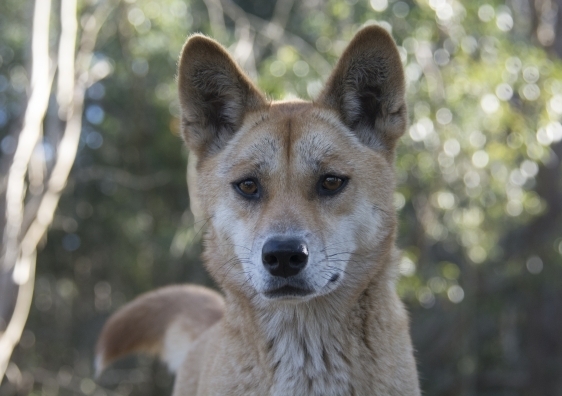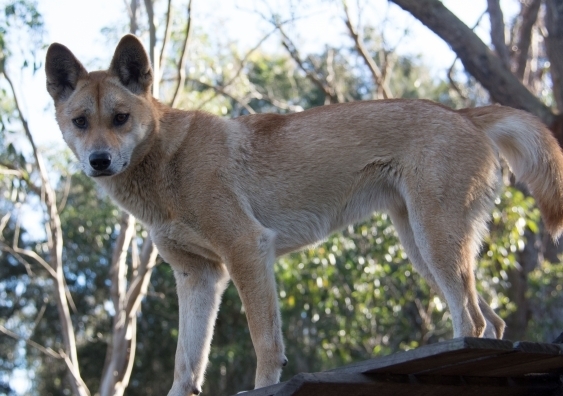Dingoes reshape the landscape
The dingo has a far greater impact on the Australian landscape than previously thought, new research reveals.
The dingo has a far greater impact on the Australian landscape than previously thought, new research reveals.

A comparison of conditions in the outback on either side of Australia’s dingo fence has revealed that extermination of predators affects not only the abundance of other animals and plants, but also reduces the quality of the soil. The UNSW study indicates greater control of kangaroo numbers is needed across a third of the Australian continent where dingoes are rare, to reduce damage on ecosystems.
“We have shown the presence of dingoes is linked to healthier soils, because they suppress the numbers of kangaroos that graze on the vegetation,” says senior author of the study, UNSW Associate Professor Mike Letnic.
The research by Letnic and his honours research student Timothy Morris has been published in the journal Proceedings of the Royal Society B.
The dingo fence, erected to keep dingoes out of eastern Australia, extends approximately 5,600km across South Australia, New South Wales and Queensland.
Dingoes are common on the western side of the fence, but rare on the other side, due to intensive control measures including poisoning, trapping and shooting. This latter area includes most of New South Wales and Victoria, and southern Queensland and southern South Australia.
The researchers studied four sites – a national park site and a pastoral site on each side of the fence in the Strzelecki Desert. They drove along outback dirt tracks at night for four years to count dingoes and kangaroos. They also collected dingo scats to determine what they ate, and measured levels of phosphorus, nitrogen and carbon in the soil.
Kangaroo numbers were high at the two study sites on the “inside” of the fence where dingoes were rare, with just one dingo and 3,245 kangaroos spotted, compared with 85 dingoes and only eight kangaroos at the two study sites “outside” the fence.
The researchers also found that where dingoes were rare, large numbers of kangaroos overgrazed vegetation cover, leading to lower levels of phosphorus, nitrogen and carbon in the soil.
“Our novel finding goes against the conventional wisdom that apex predators like dingoes have little impact on soil,” says Letnic. “We show that allowing dingo populations to increase could enhance the productivity of ecosystems across vast areas of the country by reducing herbivore numbers.
“We need to rethink the idea that kangaroos have benign impacts on ecosystems. Kangaroo numbers are very high across the approximately one-third of the continent where dingoes are rare, and are having damaging impacts on soils and vegetation,” he says.

Pure Australian desert dingo Sandy Maliki. Photo: Barry Eggleton.
A wild-born, pure Australian desert dingo called Sandy Maliki has taken out first place in the World’s Most Interesting Genome competition.
The UNSW-led proposal to have Sandy’s DNA decoded was one of five finalists for the Pacific Biosciences SMRT Grant, which provides cutting-edge sequencing of the complete genome of a fascinating plant or animal. The project won after receiving the most votes in an international online ballot.
“Sandy is truly a gift to science,” says project leader, Professor Bill Ballard of the UNSW School of Biotechnology and Biomolecular Sciences. “Pure dingoes are intermediate between wild wolves and domestic dogs, with a range of non-domesticated traits. So sequencing Sandy’s genome will help pinpoint some of the genes for temperament and behaviour that underlie the transition from wild animals to perfect pets.”
Sandy and her sister and brother were discovered as three-week-old pups in the harsh Australian desert near the Strzelecki Track in 2014 by NSW animal lovers, Barry and Lyn Eggleton, who have hand-reared them since.
The dingo sequencing project will be the first to test Charles Darwin’s 1868 theory that domestication can be divided into two steps: unconscious selection due to non-intentional human influences; and artificial selection due to breeding by humans for desired traits.
“The project will reveal the DNA changes between wolves and dingoes (unconscious selection) and dingoes and dogs (artificial selection),” says Ballard.